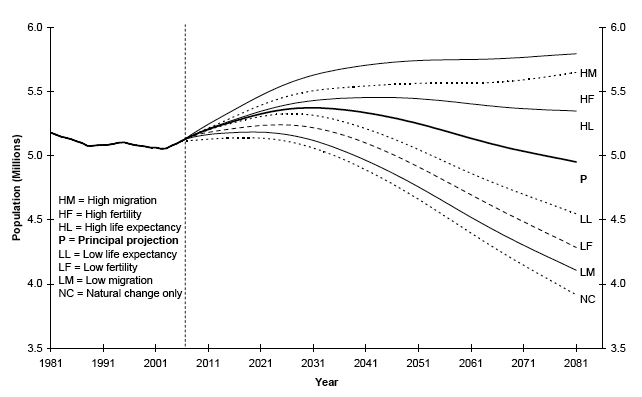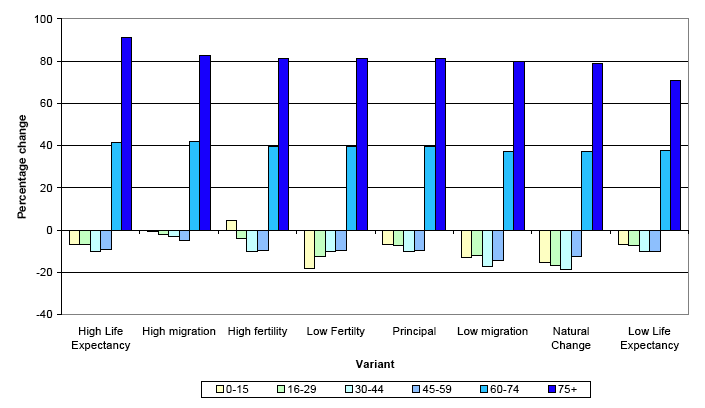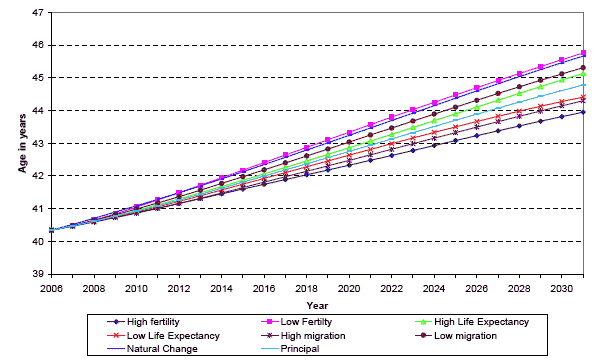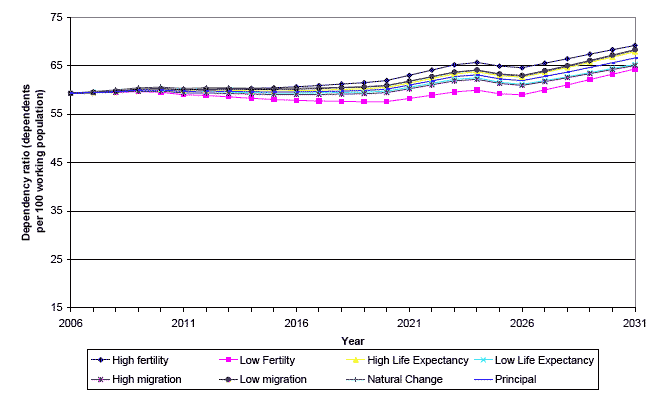
7.1 The Office for National Statistics produces projections for Scotland for up to 100 years ahead. Results for the first 75 years of this period are available from the Government Actuary’s Department’s (GAD’s) website (www.gad.gov.uk) and results beyond this are available on request. However, projections this far ahead become increasingly unreliable. As a result ONS produce a number of "variant" projections as well as the "principal" projection which most of this report concentrates on. These variant projections are based on alternative assumptions of future fertility, mortality and migration.
7.2 The variants are produced because of the inherent uncertainty of demographic behaviour, to give users an indication of this uncertainty, especially for the long-term projections. The purpose is to illustrate plausible alternative scenarios and not to represent upper or lower limits for future demographic behaviour. These projections are simply ‘scenarios’ (the certain outcome of a given set of assumptions), rather than forecasts of the most likely course of future events. At the date this report was written ONS had made available the six standard high/low variants and also a variant on "zero migration". Additional variants will be published on the GAD website in November 2007. Annex D gives more information about these variants and the assumptions used.
7.3 Figure 11 and Table 7 show that Scotland’s population is projected to rise initially under each of these alternative fertility, mortality and migration assumptions. Under the natural change only projection (which assumes there is net zero migration at all ages) the population peaks in 2018 before falling and dropping below the 2006 population in 2026. Most of the remaining variants show similar patterns with the timing of the peak varying. However, neither the high migration (assumes +17,000 migrants per year from 2012-13) nor the high fertility (assumes long term TFR of 1.85) variants peak within the 75 year period covered.
7.4 Throughout the period the natural change only projection gives the lowest population for Scotland, 0.31 million below the principal projection by 2031, 0.66 million lower in 2056 and 1.04 million lower by 2081. Inversely, the high migration projection gives the highest population, 0.25 million above the principal projection by 2031, 0.55 million higher by 2056 and 0.84million higher by 2081.
Figure 11 Actual and projected total population Scotland, under the 2006-based principal and selected variant projections, 1981-2081

7.5 Table 8 shows the projected components of population change in the period to 2031 in the principal projection, the high and low migration variants and the zero migration variant. This shows the effect that different migration assumptions have on the size of the future population. Under each of these projections the fertility and mortality assumptions are the same but the number of births and deaths change. This highlights the fact that the numbers of births and deaths are partly dependent on the assumed level of net migration.
7.6 The principal projection shows Scotland’s population increasing by 0.26 million (5 per cent) between 2006 and 2031. By comparison, the zero migration projection indicates a 0.06 million (1.1 per cent) decrease and the high migration variant projects a 0.51 million (10 per cent) increase. The total effect of migrants in the principal projection is therefore to add 0.31 million people to Scotland’s population by 2031 (0.26 million plus 0.06 million after the effects of rounding) and, under the high migration variant, to add 0.57 million (0.51 million plus 0.06 million). It is clear that the projected increase in Scotland’s population between 2006 and 2031 under the principal projection is dependent on continuing migration into Scotland.
7.7 As Figure 12 shows, under all of the variant projections, and the principal projection, Scotland’s age structure is projected to change dramatically between 2006 and 2031. In each case the number of people aged 60 and over is projected to increase significantly, particularly the number aged 75+ while, in most cases, the numbers in each of the age categories below 60 are projected to decrease. This is further demonstrated by Figure 13 which shows the average age of Scotland’s population increases under all of the variant projections.
7.8 Figure 14 shows that the dependency ratio for the number of dependents to 100 people of working age will rise under all available variant projections although the increase in the state pension age to 66 between 2024 and 2026 will result in a short term decrease. Amongst the available variants the biggest projected increase in the dependency ratio occurs under the high fertility variant (69.1 in 2031) and the lowest occurs under the low fertility variant (64.3 in 2031).
Figure 12 Percentage change in age structure under the 2006-based principal and selected variant projections, 2006-2031

Figure 13 Average age of Scotland’s population under the 2006-based principal and selected variant projections, 2006-2031

Figure 14 Dependency Ratios (dependents per 100 working population) under the 2006-based principal and selected variant projections, 2006-2031
